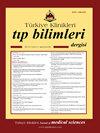Classification of Spinal Deformities: Systematic Review (Without Meta-Analysis)
Q4 Medicine
引用次数: 0
Abstract
ABS TRACT Understandably describe historical and current spinal deformity classifications. Spinal deformities can be divided into three main categories: congenital, idiopathic, and secondary spinal deformities. Secondary is by far the largest group. Congenital spinal deformities are generally seen in very early ages and may be accompanied by neural with systemic organ pathologies. Different classification systems are based on clinical and radiological symptoms since the etiology of adolescent spinal deformities is not known. On the other hand, different classification systems are based on clinical and radiological symptoms since the etiology of adolescent spinal deformities is not known. In addition to these two groups, degenerative spinal deformities in elder patients should be also considered. There is scoliosis, kyphosis, degenerative deformity, iatrogenic deformity and post traumatic deformity. Spondylolisthesis can be considered a deformity. King and Lenke are classifications for adolescent idiopathic scoliosis (AIS) and are designed to guide fusion levels for the treatment of AIS. The Lenke classification arose to address 2 issues. One was sagittal deformity and second was that with newer instrumentation techniques there were more treatment options. Schwab and Scoliosis Research Society classifications are classifications of adult spinal deformity. The key addition in these systems is the introduction of lumbar lordosis and pelvic parameters. This includes adult sequelae of AIS but also degenerative deformity.脊柱畸形的分类:系统综述(无meta分析)
可以理解地描述历史和当前脊柱畸形分类。脊柱畸形可分为三大类:先天性、特发性和继发性脊柱畸形。Secondary是目前最大的群体。先天性脊柱畸形通常出现在非常早期的年龄,并可能伴有神经和全身器官病变。由于青少年脊柱畸形的病因尚不清楚,不同的分类系统是基于临床和放射学症状。另一方面,由于青少年脊柱畸形的病因尚不清楚,不同的分类系统是基于临床和放射学症状。除上述两组外,还应考虑老年患者的退行性脊柱畸形。有脊柱侧凸、后凸、退行性畸形、医源性畸形和创伤后畸形。脊柱滑脱可被认为是一种畸形。King和Lenke是针对青少年特发性脊柱侧凸(AIS)的分类,旨在指导AIS治疗的融合水平。Lenke的分类是为了解决两个问题。一个是矢状畸形,第二个是新的器械技术有了更多的治疗选择。Schwab和脊柱侧凸研究协会的分类是成人脊柱畸形的分类。这些系统的关键补充是腰椎前凸和骨盆参数的引入。这包括成人AIS的后遗症,也包括退行性畸形。
本文章由计算机程序翻译,如有差异,请以英文原文为准。
求助全文
约1分钟内获得全文
求助全文

 求助内容:
求助内容: 应助结果提醒方式:
应助结果提醒方式:


